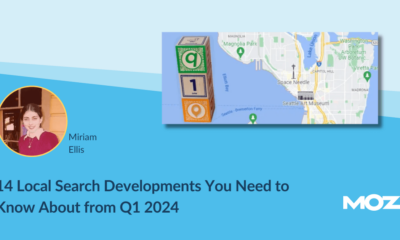MARKETING
Local Pack Header Specificity Vanishes while Local Packs Downtrend

The author’s views are entirely his or her own (excluding the unlikely event of hypnosis) and may not always reflect the views of Moz.
In July of this year, Dr. Peter J. Meyers and I published a report analyzing an element of Google’s local results we termed “local pack headers”. About a month after publication, members of the local SEO community, like Colan Nielsen, began noticing that the extraordinary diversity of headings we had captured had suddenly diminished:
Today, I’m doing a quick follow-up to the manual portion of our earlier study in an effort to quantify and illustrate this abrupt alteration.
A total sea change in local pack headers
Between July and November of 2022, 83% of our previously-queried local pack headers underwent a complete transformation of nomenclature. Only 17% of the local pack headers were still worded the same way in autumn as they had been in the summertime. Here is a small set of examples:

In our manual analysis of 60 queries in July, we encountered 40 unique local pack headers – a tremendous variety. Now, all specificity is gone. For all of our queries, headings have been reduced to just 3 types: in-store availability, places, and businesses.
Entity relationships remain mysterious
What hasn’t changed is my sense that the logic underpinning which businesses receive which local pack header remains rather odd. In the original study, we noted the mystery of why a query like “karate” fell under the heading of “martial arts school” but a query for “tai chi” got a unique “tai chi heading”, or why “adopt dog” results were headed “animal rescue services” but “adopt bunny” got a pack labeled “adopt bunny”. The curious entity relationships continue on, even in this new, genericized local pack header scenario. For example, why is my search for “tacos” (which formerly brought up a pack labeled “Mexican restaurants”, now labeled this:

But my search for “oil change” gets this header:

Is there something about a Mexican restaurant that makes it more of a “place” and an oil change spot that makes it more of a “business”? I don’t follow the logic. Meanwhile, why are service area businesses, as shown in my search for “high weed mowing” being labeled “places”?

Surely high weed mowing is not a place…unless it is a philosophical one. Yet I saw many SABs labeled this way instead of as “businesses”, which would seem a more rational label, given Google’s historic distinction between physical premises and go-to-client models. There are many instances like this of the labeling not making much horse sense, and with the new absence of more specific wording, it feels like local pack headers are likely to convey less meaning and be more easily overlooked now.
Why has Google done this and does it matter to your local search marketing?
Clearly, Google decided to streamline their classifications. There may be more than three total local pack header types, but I have yet to see them. Hotel packs continue to have their own headings, but they have always been a different animal:

In general, Google experiments with whatever they think will move users about within their system, and perhaps they felt the varied local pack headers were more of a distraction than an aid to interactivity with the local packs. We can’t know for sure, nor can we say how long this change will remain in place, because Google could bring back the diverse headings the day after I publish this column!
As to whether this matters to your local search campaigns, unfortunately, the generic headers do obscure former clues to the mind of Google that might have been useful in your SEO. I previously suggested that local businesses might want to incorporate the varied local pack terms into the optimization of the website tags and text, but in the new scenario, it is likely to be pointless to optimize anything for “places”, “businesses”, or “in-store availability”. It’s a given that your company is some kind of place or business if you’re creating a Google Business Profile for it. And, your best bet for featuring that you carry certain products is to publish them on your listing and consider whether you want to opt into programs like Pointy.
In sum, this change is not a huge deal, but I’m a bit sorry to see the little clues of the diversified headers vanish from sight. Meanwhile, there’s another local pack trend going on right now that you should definitely be paying attention to…
A precipitous drop in overall local pack presence

In our original study, Google did not return a local pack for 18% of our manual July queries. By November, the picture had significantly changed. A startling 42% of our queries suddenly no longer displayed a local pack. This is right in line with Andrew Shotland’s documentation of a 42.3% drop from peak local pack display between August and October. Mozcast, pictured above, captured a drop from 39.6% of queries returning local packs on October 24th to just 25.1% on October 25th. The number has remained in the low-to-mid 20s in the ensuing weeks. It’s enough of a downward slope to give one pause.
Because I’m convinced of the need for economic localism as critical to healing the climate and society, I would personally like Google to return local packs for all commercial queries so that searchers can always see the nearest resource for purchasing whatever they need, but if Google is reducing the number of queries for which they deliver local results, I have to try to understand their thinking.
To do that, I have to remember that the presence of a local pack is a signal that Google believes a query has a local intent. Likely, they often get this right, but I can think of times when a local result has appeared for a search term that doesn’t seem to me to be obviously, inherently local. For example, in the study Dr. Pete and I conducted, we saw Google not just returning a local pack for the keyword “pickles” but even giving it its own local pack header:

If I search for pickles, am I definitely looking for pickles near me, or could I be looking for recipes, articles about the nutritional value of pickles, the history of pickles, something else? How high is Google’s confidence that vague searches like these should be fulfilled with a local result?
After looking at a number of searches like these in the context of intent, my current thinking is this: for some reason unknown to us, Google is dialing back presumed local intent. Ever since Google made the user the centroid of search and began showing us nearby results almost by default for countless queries, we users became trained not to have to add many (or any) modifiers to our search language to prompt Google to lay out our local options for us. We could be quite lazy in our searches and still get local results.
In the new context of a reduced number of searches generating local packs, though, we will have to rehabituate ourselves to writing more detailed queries to get to what we want if Google no longer thinks our simple search for “pickles” implies “pickles near me”. I almost get the feeling that Google wants us to start being more specific again because its confidence level about what constitutes a local search has suffered some kind of unknown challenge.
It’s also worth throwing into our thinking what our friends over at NearMedia.co have pointed out:
“The Local Pack’s future is unclear. EU’s no “self-preferencing” DMA takes effect in 2023. The pending AICOA has a similar language.”
It could be that Google’s confidence is being shaken in a variety of ways, including by regulatory rulings, and local SEOs should always expect change. For now, though, local businesses may be experiencing some drop in their local pack traffic and CTR. On the other hand, if Google is getting it right, there may be no significant loss. If your business was formerly showing up in a local pack for a query that didn’t actually have a local intent, you likely weren’t getting those clicks anyway because a local result wasn’t what the searcher was looking for to begin with.
That being said, I am seeing examples in which I feel Google is definitely getting it wrong. For instance, my former searches for articles of furniture all brought up local packs with headings like “accent chairs” or “lamps”. Now, Google is returning no local pack for some of these searches and is instead plugging an enormous display of remote, corporate shopping options. There are still furniture stores near me, but Google is now hiding them, and that disappoints me greatly:

So here’s today’s word to the wise: keep working on the organic optimization of your website and the publication of helpful content. Both will underpin your key local pack rankings, and as we learned from our recent large-scale local business review survey, 51% of consumers are going to end up on your site as their next step after reading reviews on your listings. 2023 will be a good year to invest in the warm and inclusive welcome your site is offering people, and the investment will also stand you in good stead however local pack elements like headers, or even local packs, themselves, wax and wane.
MARKETING
18 Events and Conferences for Black Entrepreneurs in 2024

Welcome to Breaking the Blueprint — a blog series that dives into the unique business challenges and opportunities of underrepresented business owners and entrepreneurs. Learn how they’ve grown or scaled their businesses, explored entrepreneurial ventures within their companies, or created side hustles, and how their stories can inspire and inform your own success.
It can feel isolating if you’re the only one in the room who looks like you.
MARKETING
IAB Podcast Upfront highlights rebounding audiences and increased innovation


Podcasts are bouncing back from last year’s slowdown with digital audio publishers, tech partners and brands innovating to build deep relationships with listeners.
At the IAB Podcast Upfront in New York this week, hit shows and successful brand placements were lauded. In addition to the excitement generated by stars like Jon Stewart and Charlamagne tha God, the numbers gauging the industry also showed promise.
U.S. podcast revenue is expected to grow 12% to reach $2 billion — up from 5% growth last year — according to a new IAB/PwC study. Podcasts are projected to reach $2.6 billion by 2026.
The growth is fueled by engaging content and the ability to measure its impact. Adtech is stepping in to measure, prove return on spend and manage brand safety in gripping, sometimes contentious, environments.
“As audio continues to evolve and gain traction, you can expect to hear new innovations around data, measurement, attribution and, crucially, about the ability to assess podcasting’s contribution to KPIs in comparison to other channels in the media mix,” said IAB CEO David Cohen, in his opening remarks.
Comedy and sports leading the way
Podcasting’s slowed growth in 2023 was indicative of lower ad budgets overall as advertisers braced for economic headwinds, according to Matt Shapo, director, Media Center for IAB, in his keynote. The drought is largely over. Data from media analytics firm Guideline found podcast gross media spend up 21.7% in Q1 2024 over Q1 2023. Monthly U.S. podcast listeners now number 135 million, averaging 8.3 podcast episodes per week, according to Edison Research.
Comedy overtook sports and news to become the top podcast category, according to the new IAB report, “U.S. Podcast Advertising Revenue Study: 2023 Revenue & 2024-2026 Growth Projects.” Comedy podcasts gained nearly 300 new advertisers in Q4 2023.
Sports defended second place among popular genres in the report. Announcements from the stage largely followed these preferences.
Jon Stewart, who recently returned to “The Daily Show” to host Mondays, announced a new podcast, “The Weekly Show with Jon Stewart,” via video message at the Upfront. The podcast will start next month and is part of Paramount Audio’s roster, which has a strong sports lineup thanks to its association with CBS Sports.
Reaching underserved groups and tastes
IHeartMedia toasted its partnership with radio and TV host Charlamagne tha God. Charlamagne’s The Black Effect is the largest podcast network in the U.S. for and by black creators. Comedian Jess Hilarious spoke about becoming the newest co-host of the long-running “The Breakfast Club” earlier this year, and doing it while pregnant.
The company also announced a new partnership with Hello Sunshine, a media company founded by Oscar-winner Reese Witherspoon. One resulting podcast, “The Bright Side,” is hosted by journalists Danielle Robay and Simone Boyce. The inspiration for the show was to tell positive stories as a counterweight to negativity in the culture.
With such a large population listening to podcasts, advertisers can now benefit from reaching specific groups catered to by fine-tuned creators and topics. As the top U.S. audio network, iHeartMedia touted its reach of 276 million broadcast listeners.
Connecting advertisers with the right audience
Through its acquisition of technology, including audio adtech company Triton Digital in 2021, as well as data partnerships, iHeartMedia claims a targetable audience of 34 million podcast listeners through its podcast network, and a broader audio audience of 226 million for advertisers, using first- and third-party data.
“A more diverse audience is tuning in, creating more opportunities for more genres to reach consumers — from true crime to business to history to science and culture, there is content for everyone,” Cohen said.
The IAB study found that the top individual advertiser categories in 2023 were Arts, Entertainment and Media (14%), Financial Services (13%), CPG (12%) and Retail (11%). The largest segment of advertisers was Other (27%), which means many podcast advertisers have distinct products and services and are looking to connect with similarly personalized content.
Acast, the top global podcast network, founded in Stockholm a decade ago, boasts 125,000 shows and 400 million monthly listeners. The company acquired podcast database Podchaser in 2022 to gain insights on 4.5 million podcasts (at the time) with over 1.7 billion data points.
Measurement and brand safety
Technology is catching up to the sheer volume of content in the digital audio space. Measurement company Adelaide developed its standard unit of attention, the AU, to predict how effective ad placements will be in an “apples to apples” way across channels. This method is used by The Coca-Cola Company, NBA and AB InBev, among other big advertisers.
In a study with National Public Media, which includes NPR radio and popular podcasts like the “Tiny Desk” concert series, Adelaide found that NPR, on average, scored 10% higher than Adelaide’s Podcast AU Benchmarks, correlating to full-funnel outcomes. NPR listeners weren’t just clicking through to advertisers’ sites, they were considering making a purchase.
Advertisers can also get deep insights on ad effectiveness through Wondery’s premium podcasts — the company was acquired by Amazon in 2020. Ads on its podcasts can now be managed through the Amazon DSP, and measurement of purchases resulting from ads will soon be available.
The podcast landscape is growing rapidly, and advertisers are understandably concerned about involving their brands with potentially controversial content. AI company Seekr develops large language models (LLMs) to analyze online content, including the context around what’s being said on a podcast. It offers a civility rating that determines if a podcast mentioning “shootings,” for instance, is speaking responsibly and civilly about the topic. In doing so, Seekr adds a layer of confidence for advertisers who would otherwise pass over an opportunity to reach an engaged audience on a topic that means a lot to them. Seekr recently partnered with ad agency Oxford Road to bring more confidence to clients.
“When we move beyond the top 100 podcasts, it becomes infinitely more challenging for these long tails of podcasts to be discovered and monetized,” said Pat LaCroix, EVP, strategic partnerships at Seekr. “Media has a trust problem. We’re living in a time of content fragmentation, political polarization and misinformation. This is all leading to a complex and challenging environment for brands to navigate, especially in a channel where brand safety tools have been in the infancy stage.”
Dig deeper: 10 top marketing podcasts for 2024
MARKETING
Foundations of Agency Success: Simplifying Operations for Growth


Why do we read books like Traction, Scaling Up, and the E-Myth and still struggle with implementing systems, defining processes, and training people in our agency?
Those are incredibly comprehensive methodologies. And yet digital agencies still suffer from feast or famine months, inconsistent results and timelines on projects, quality control, revisions, and much more. It’s not because they aren’t excellent at what they do. I
t’s not because there isn’t value in their service. It’s often because they haven’t defined the three most important elements of delivery: the how, the when, and the why.
Complicating our operations early on can lead to a ton of failure in implementing them. Business owners overcomplicate their own processes, hesitate to write things down, and then there’s a ton of operational drag in the company.
Couple that with split attention and paper-thin resources and you have yourself an agency that spends most of its time putting out fires, reacting to problems with clients, and generally building a culture of “the Founder/Creative Director/Leader will fix it” mentality.
Before we chat through how truly simple this can all be, let’s first go back to the beginning.
When we start our companies, we’re told to hustle. And hustle hard. We’re coached that it takes a ton of effort to create momentum, close deals, hire people, and manage projects. And that is all true. There is a ton of work that goes into getting a business up and running.


The challenge is that we all adopt this habit of burning the candle at both ends and the middle all for the sake of growing the business. And we bring that habit into the next stage of growth when our business needs… you guessed it… exactly the opposite.
In Mike Michalowitz’s book, Profit First he opens by insisting the reader understand and accept a fundamental truth: our business is a cash-eating monster. The truth is, our business is also a time-eating monster. And it’s only when we realize that as long as we keep feeding it our time and our resources, it’ll gobble everything up leaving you with nothing in your pocket and a ton of confusion around why you can’t grow.
Truth is, financial problems are easy compared to operational problems. Money is everywhere. You can go get a loan or go create more revenue by providing value easily. What’s harder is taking that money and creating systems that produce profitably. Next level is taking that money, creating profit and time freedom.
In my bestselling book, The Sabbatical Method, I teach owners how to fundamentally peel back the time they spend in their company, doing everything, and how it can save owners a lot of money, time, and headaches by professionalizing their operations.
The tough part about being a digital agency owner is that you likely started your business because you were great at something. Building websites, creating Search Engine Optimization strategies, or running paid media campaigns. And then you ended up running a company. Those are two very different things.


How to Get Out of Your Own Way and Create Some Simple Structure for Your Agency…
- Start Working Less
I know this sounds really brash and counterintuitive, but I’ve seen it work wonders for clients and colleagues alike. I often say you can’t see the label from inside the bottle and I’ve found no truer statement when it comes to things like planning, vision, direction, and operations creation.
Owners who stay in the weeds of their business while trying to build the structure are like hunters in the jungle hacking through the brush with a machete, getting nowhere with really sore arms. Instead, define your work day, create those boundaries of involvement, stop working weekends, nights and jumping over people’s heads to solve problems.
It’ll help you get another vantage point on your company and your team can build some autonomy in the meantime.
- Master the Art of Knowledge Transfer
There are two ways to impart knowledge on others: apprenticeship and writing something down. Apprenticeship began as a lifelong relationship and often knowledge was only retained by ONE person who would carry on your method.
Writing things down used to be limited (before the printing press) to whoever held the pages.
We’re fortunate that today, we have many ways of imparting knowledge to our team. And creating this habit early on can save a business from being dependent on any one person who has a bunch of “how” and “when” up in their noggin.
While you’re taking some time to get out of the day-to-day, start writing things down and recording your screen (use a tool like loom.com) while you’re answering questions.


Deposit those teachings into a company knowledge base, a central location for company resources. Some of the most scaleable and sellable companies I’ve ever worked with had this habit down pat.
- Define Your Processes
Lean in. No fancy tool or software is going to save your company. Every team I’ve ever worked with who came to me with a half-built project management tool suffered immensely from not first defining their process. This isn’t easy to do, but it can be simple.
The thing that hangs up most teams to dry is simply making decisions. If you can decide how you do something, when you do it and why it’s happening that way, you’ve already won. I know exactly what you’re thinking: our process changes all the time, per client, per engagement, etc. That’s fine.
Small businesses should be finding better, more efficient ways to do things all the time. Developing your processes and creating a maintenance effort to keep them accurate and updated is going to be a liferaft in choppy seas. You’ll be able to cling to it when the agency gets busy.
“I’m so busy, how can I possibly work less and make time for this?”


You can’t afford not to do this work. Burning the candle at both ends and the middle will catch up eventually and in some form or another. Whether it’s burnout, clients churning out of the company, a team member leaving, some huge, unexpected tax bill.
I’ve heard all the stories and they all suck. It’s easier than ever to start a business and it’s harder than ever to keep one. This work might not be sexy, but it gives us the freedom we craved when we began our companies.
Start small and simple and watch your company become more predictable and your team more efficient.
-

 PPC6 days ago
PPC6 days agoHow the TikTok Algorithm Works in 2024 (+9 Ways to Go Viral)
-

 SEO5 days ago
SEO5 days agoHow to Use Keywords for SEO: The Complete Beginner’s Guide
-

 MARKETING6 days ago
MARKETING6 days agoHow To Protect Your People and Brand
-

 MARKETING4 days ago
MARKETING4 days agoAdvertising on Hulu: Ad Formats, Examples & Tips
-

 MARKETING4 days ago
MARKETING4 days agoUpdates to data build service for better developer experiences
-

 MARKETING5 days ago
MARKETING5 days agoThe Ultimate Guide to Email Marketing
-

 MARKETING21 hours ago
MARKETING21 hours ago18 Events and Conferences for Black Entrepreneurs in 2024
-

 SEO7 days ago
SEO7 days agoAutomate Multi-Site Reporting With Google Sheets And GSC API

















You must be logged in to post a comment Login